John Hudson was born in Shepshed, Leicestershire, in November 1819, the son of John and Martha Hudson. He was baptised at St Botolph’s Church on 30th January 1820.
John grew up in Shepshed, living at Ticklow Lane Gate. By 1836 his parents moved to Loughborough and then, by 1841, on to Ticknall in Derbyshire, where his father was employed as a gamekeeper to Sir George Harpur-Crewe. However John, then 17, remained in Shepshed.
Notes made by John and Caroline’s great-great-grandson Leslie Cox1 record that John was trained as a gamekeeper on the Garendon Estate, situated between Shepshed and Loughborough and that John ‘recalled an interesting incident from those days. In 1837, when Queen Victoria came to the throne, he was helping the woodmen to mow the rides in Garendon Park when news came of the Queen’s accession. Apparently they had not heard the name Victoria before, and one of them referred to her as Queen Vicmaria!’
On Sunday 13th, 20th, and 27th November 1842, banns of marriage were read at All Saints’ Church, Loughborough, between John Hudson ‘of Sheepshed’ and Caroline Hinds Dexter ‘of the Parish of Loughborough’. Banns were also read at St Botolph’s Church, Shepshed, on Sunday 20th and 27th of November, and 4th December. They were married at All Saints’ Church, Loughborough, on 5th November, with John’s sister Elizabeth being one of their witnesses.

Caroline was born on 17th November 1823 in Diseworth, Leicestershire, the daughter of William Hinds, a farm labourer and shepherd, and his wife Martha. She was baptised on 28th November 1824 at St Nicholas’ Church, Diseworth. Caroline’s father William was born before his parents married, so had the surname Hinds, being that of Caroline’s paternal grandmother. However, between 1839 and 1841 the family started using the surname Dexter, being the surname of William’s father, and Hinds was used as a middle name: Caroline became known as Caroline Hinds Dexter. At the time of the 1841 census, Caroline was working at Shepshed, where she likely met John, although she was living at Swan Street, Loughborough, at the time of their marriage.

John and Caroline initially lived at Shepshed, with John working as a labourer. Here their first child Mary was baptised on 31st March 1843, although she died shortly afterwards and was buried on 4th April 1843. Their second child, also named Mary, was born on 26th March 1844 in Shepshed.
The Calke Estate
Sir George Harpur-Crewe, for whom John’s father was working as a gamekeeper, died in 1844. Leslie Cox noted that ‘his son and heir John was living in Loughborough, and when he succeeded to the title and estates, he brought John Hudson with him as a gamekeeper’. John’s parents, John and Martha Hudson, moved back to Shepshed around this time while John Hudson junior assumed his father’s role as a gamekeeper at Calke.
John and Caroline moved to Smisby, living at Wicket Nook Cottage at Pistern Hills on the Calke Estate. In 1846, their third child Caroline was born in February, who was baptised together with her older sister Mary on 12th April at Smisby. In 1848, their fourth child Hannah was born in January, being baptised on 20th February.
John and Caroline’s fifth child and first son John Hudson was born in November 1849 and baptised at Smisby on 6th January 1850.
The family were living at Pistern Hills, Smisby, at the time of the 1851 census. Caroline’s mother, Martha, was also at the house, perhaps visiting her infant grandson, while her family remained at Shepshed.
John and Martha’s next child, Elizabeth, was born in January 1852 and baptised on 22nd February at Smisby. She was followed by Martha in May 1854, their last child to be born at Wicket Nook Cottage, who was baptised on 13th August.
John and Caroline’s eighth child, Emma, is recorded as being born in Repton in February 1856. Leslie Cox noted that ‘it appears that therefore before her birth the family moved...from Wicket Nook to a small place called Southwood Farm which also served as a keepers cottage. Southwood is a few miles from Repton itself but Southwood was a outlying detached portion of the parish.’ Emma was baptised on 23rd March 1856 at St James’ Church, Smisby, and the family are recorded as living at the ‘Southwood parish of Repton’.
Leslie noted that ‘when in later years the children remembered their childhood days at Wicket Nook, Caroline recalled her parents shopping trips to Ashby-de-la-Zouch when a black retriever dog was left in charge at the cottage - to keep the children in and intruders out. Hannah, in a number of poems, described their surroundings, going with her brother John to pick coal fallen from the waggons on the old Ticknall tramway, helping to make hay in the fields near the cottage, and feeding the pheasant chicks reared for the shoot by her father.’
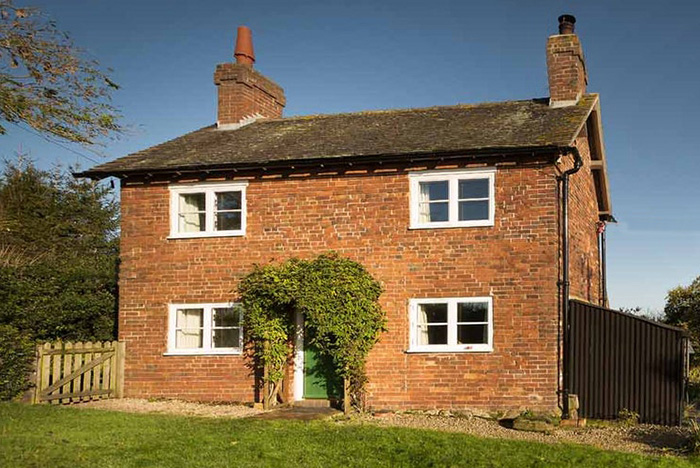 Wicket Nook Cottage, now owned by the National Trust
Wicket Nook Cottage, now owned by the National Trust
Leslie noted that ‘the children attended school at Ticknall which meant a walk of three miles. The girls attended Lady Crewe’s school near the Ticknall Lodge gates and John, the only boy at that time, attended the boys’ school in the village. John was given the special privilege of going to Lady Crewe’s school at mid-day to have lunch with his sisters.’ Meanwhile, their father John continued to work as a gamekeeper.
Gamekeeper
On 19th December 1854 John attended the Swarkestone Petty Sessions in a case of trespassing:

The Night Poaching Act 1828 forbids entering land at night to take or destroy game, which includes rabbits, hares, pheasants, partridges, and grouse. The job of gamekeeper came with danger. Poaching was rarely a sole pursuit and occupied the time of hardened characters. In summing up, the Judge in the following case commented:
‘In general, the habit of poaching drew men away from, and unfitted them for, honest and reputable pursuits, and it was awful to contemplate the serious and fatal results arising from the nightly assembling of bodies of men in numbers, and more or less armed, entering the property of others, prepared to offer violent resistance to their apprehension, while pursuing their unlawful avocation.’
In the early hours of Monday morning, 12th January 1857, John was involved in an event which resulted in a £100 reward being offered to capture a group of poachers.
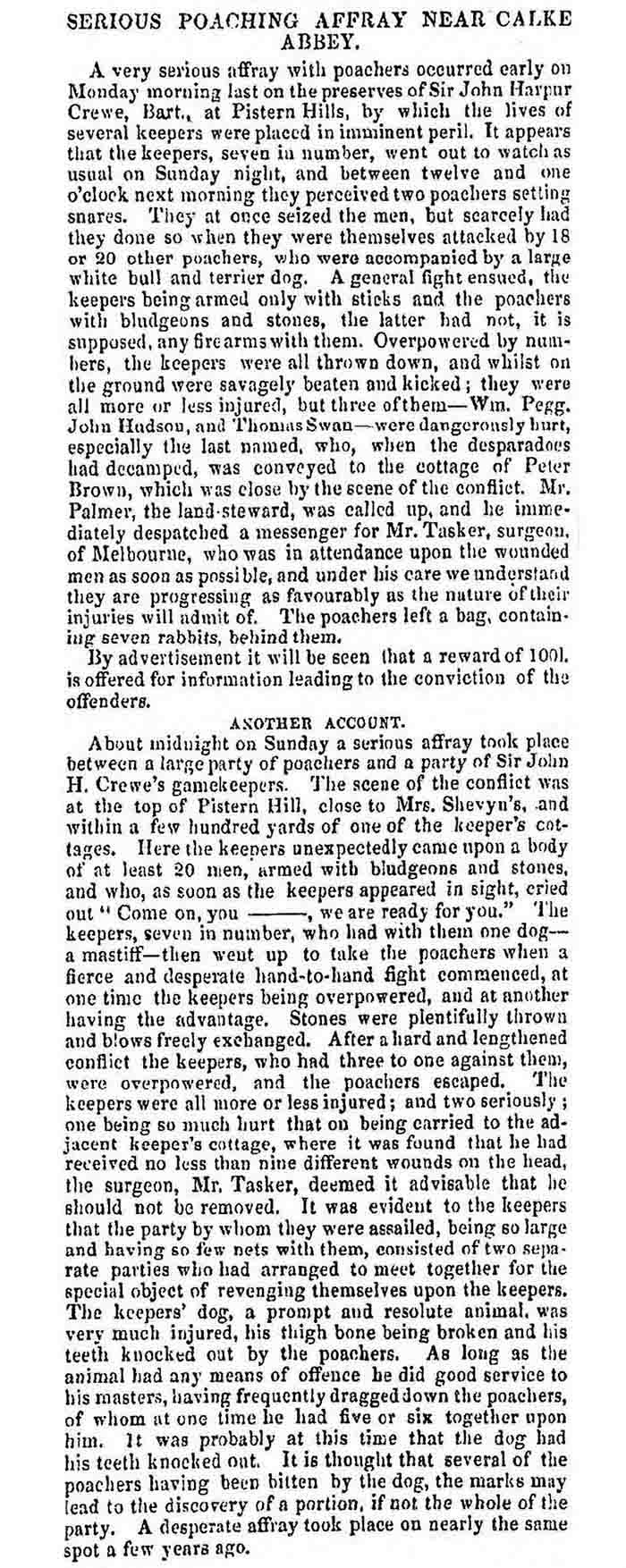
One of the poachers was tempted by the £100 offered by Sir John Harpur-Crewe and at the trial ‘pleaded guilty on the understanding that he should give evidence against the others’. Four other men were put on trial in March, ‘charged with entering a certain close of land in the occupation of Robert Tomlinson, armed with bludgeons, for the purpose of taking and destroying rabbits’. William Pegg was the head gamekeeper to Sir John Harpur-Crewe and with John Hudson and a man called Swann, came across a group of ‘12-15 men’ in a field at Smisby. The poachers challenged the gamekeepers saying ‘come up, lads’, throwing stones at them, and then had ‘a regular set to, and beat the keepers in a fight’. One of the men on trial was later seen to have a black eye, suggested as being delivered by John Hudson. John himself was also hurt.

The jury acquitted one man but found the three others guilty, each receiving a sentence of twelve months’ imprisonment. The man who gave evidence against the others received the same sentence.
Later in July 1857 two additional men were charged, with John attending the trial.
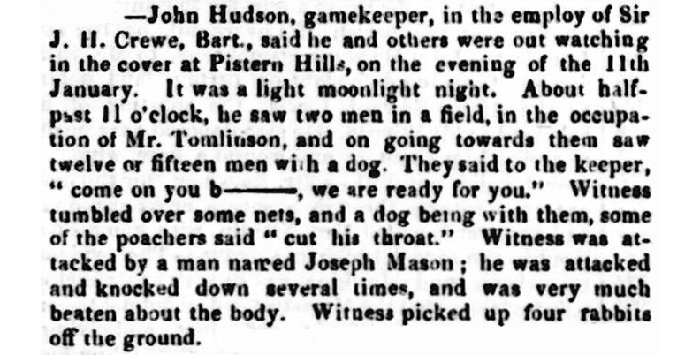
Both men received a twelve month sentence. A further man was charged in December.
Leslie Cox noted that ‘in 1858 the family moved from Wicket Nook to a cottage known as The Whimsey, now in ruins, on the edge of Calke Park and close to Middle Lodge where John and Martha [John’s parents] had lived during the time of Sir George [Harpur-Crewe]. The Whimsey was also close to Lady Crewe’s school which the girls continued to attend.’
‘Whimsey’ implies a winding engine house and the stone building is thought originally to have comprised of an engine house and stables, but had been converted into two cottages and stables by the middle of the nineteenth century. The cottages were destroyed by the army in the 1940’s.
In his book, Leslie Cox wrote that ‘to assist John Hudson with his growing family, Sir John allowed him to graze a milking cow in the park. The cow was looked after by Caroline and the girls, and became so used to female company that when it was sold, it refused to leave the park until Caroline walked in front of it, wearing her shawl.’ In his notes, Leslie Cox originally wrote that ‘Sir John gave him a cow and allowed it to graze in the park’,2 but that may have been too generous a gift to be true. The milk, however, would have been invaluable for the young family.
Leslie also noted that ‘after a short period at the Whimsey, the family moved to The Kennels, another keepers cottage a short distance away.’ John and Caroline’s next children were born here; Samuel in June 1858 (baptised on 29th August) and William in July 1860 (baptised on 8th December). John gave his address as ‘The Kennels, Derby Hills’ at both baptisms.
Ferry House, Twyford
Towards then end of 1860, the family moved again. Leslie recorded that ‘Thomas Fisher, a gamekeeper at Twyford, a hamlet on the northern boundary of the [Calke] Estate, died [he was buried on 10th May 1860]. His duties also included looking after the ferry boat on the river Trent and there was a small farm attached. His widow decided to carry on with the farm and the ferry, but the post of gamekeeper was offered by Sir John to John Hudson. It was accepted...It was at first intended that the Hudsons should live at Stenson near the canal...but John Hudson was apprehensive about bringing his children to live so close to the canal, and in the event Samuel Hicklin moved to Stenson to make way for the Hudsons at Twyford.’
A ‘Specification and Estimate’ made by Thomas Marriott of Ticknall dated 5th October 1860 records work that was ‘propsed to be done at a house at Twyford, the property of Sir John Harpur Crew Bart., lately occupied by Samuel Hicklin, and proposed to be occupied by John Hudson, one of Sir John’s Keepers.’ The document shows that there was an old lean-to at the back of the house, which was to be taken down, and the materials were to be dressed and reused to build a new two-storey extension, which would sit on foundations dug four feet deep. The ground floor of the new building would comprise of a kitchen with a window and fire place. The kitchen would be accessed from a door at the back of the old house, as well as a new side door from the kitchen. A door in the kitchen would lead into a new pantry, and from there in to a new larder through another door. The floor of the kitchen, pantry, and larder, were to be ‘bricks, flat, bedded in mortar’. In the room above, a studded wall would divide it into two ‘chambers’, each with a window. It doesn’t mention how these upper rooms would be accessed. The walls and ‘plaster on reed’ ceilings were to be ‘three coats whitewashed’ and Staffordshire tiles and lead guttering would be be used on the roof.
Carpentry work was also required. The estimate included ‘to find and fix three rails and hooks in the larder to hang game upon, and three pantry shelves to one side and wood bearers...and to find and fix three shelves and wood bearers in pantry.’ The cost for the building and carpentry work was estimated at £65 10s.
Additional work included the sinking and building of a well with a new pump; sinking a soft water cistern with a pump; fitting a ‘sink stove’ in the kithchen; finding ‘a oven and boiler and ashes grate’; and ‘to find and fix a 14 gallon washing copper and underworks’.
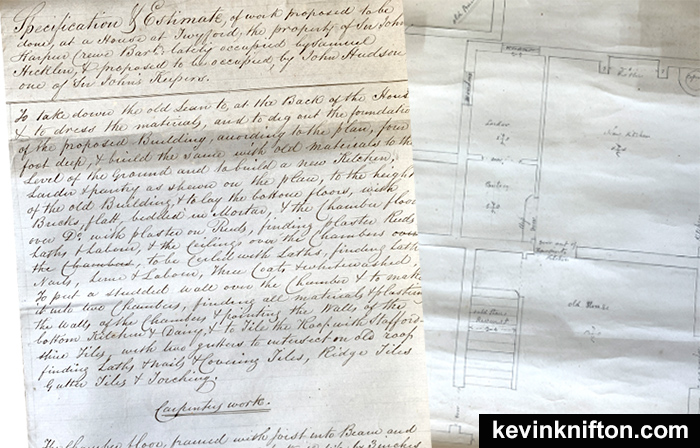 Specification and estimate for work at Ferry House, Twyford, October 1860
Specification and estimate for work at Ferry House, Twyford, October 1860
Photographs of the house from 1889 show that the building work did go ahead. Leslie Cox wrote that ‘one day the Hudsons piled their belongings on the cart and a wagon provided by the Estate and moved to a small cottage holding near Twyford Ferry. This was to remain the family home for the next ninety years. ..... The land round the cottage at Twyford was subject to flooding in the winter months and over the years the family home came to be referred to as ‘Noah’s Ark’.’
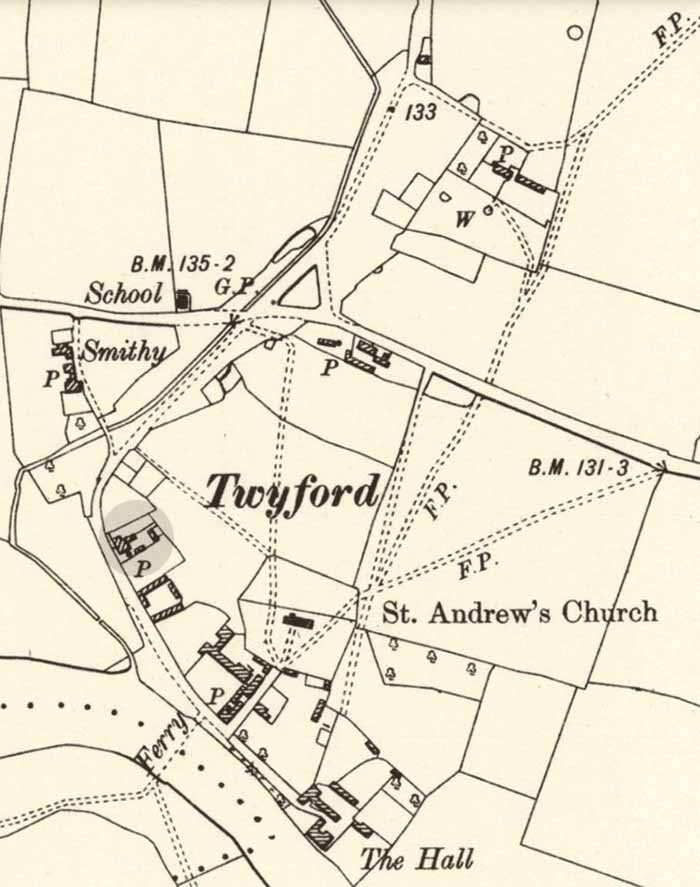 Location of Ferry House, home of the Hudsons from 1860
Location of Ferry House, home of the Hudsons from 1860
Leslie noted that ‘not long after the move to Twyford, the Hudson children contracted typhoid fever due, it was thought, to faulty drains at the keepers cottage.’ This was in 1861 and their second son Samuel died at the age of 3. He was buried in the churchyard at St Andrew’s Church on 3rd August. Leslie continues; ‘Sir John showed his concern by sending his coachmen daily to the opposite side of the river at Twyford Ferry to call across for news of the family. In this way, direct contact with the disease was avoided. It is interesting to recall that later on when the Hudson children had chicken pox, Sir John sent his own family over to Twyford to have tea with the Hudsons so that they would catch the complaint.’
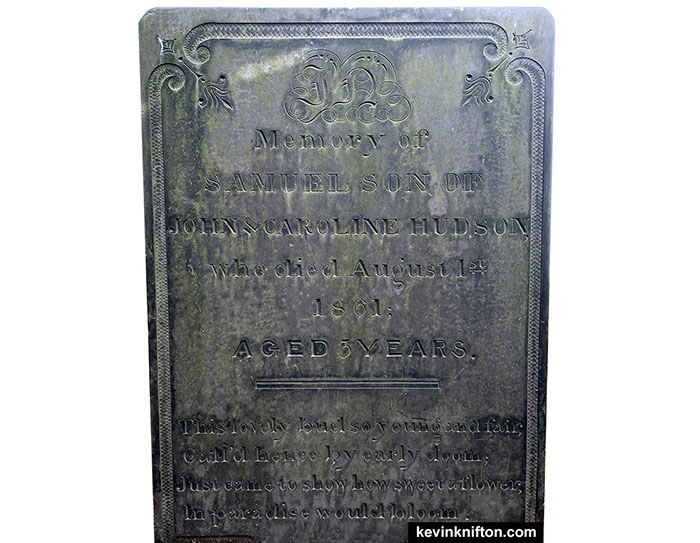 ‘In Memory of Samuel son of John & Caroline Hudson,
‘In Memory of Samuel son of John & Caroline Hudson,who died August 1st 1861; aged 3 years.
This lovely bud so young and fair, Call’d hence by early doom;
Just came to show how sweet a flower, In paradise would bloom.’
The steward’s accounts for Calke Abbey record that John received a gratuity on 2nd September 1861 relating to ‘family in illness’.

More bad news came in August when on the 11th, Caroline’s mother was found dead: she had hanged herself. An inquest noted that she had ‘suffered much from pain and palpitation of the heart for many years, and occasionally was very much depressed in spirits’.
On 26th November 1862 John attended the Derby County Police Court where four ‘notorious poachers’ were charged for poaching. They were found to have ‘in their possession game and implements used for the purpose of unlawfully taking game’ on 20th November. Police had stopped the men at 2 a.m. on the road at Stenson railway bridge and they each had ‘a bag on their backs and carried large sticks in their hands’. The men refused to show the police what was in their bags, and one of them ran away, dropping his bag, which was found to contain ‘three warm rabbits and a net’. The prosecution had to prove that the men had been ‘unlawfully on land in search or pursuit of game’, rather than having obtained the rabbits by some other means. John Hudson was called as a witness.
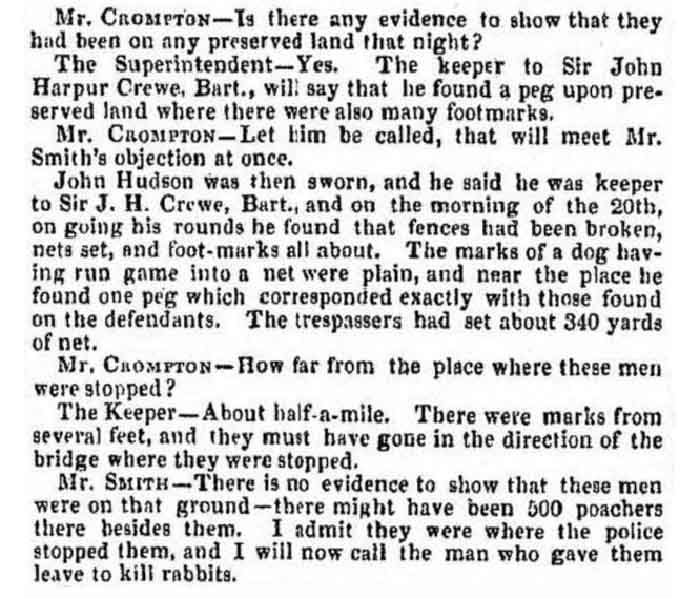
The men were convicted, each fined £5 and costs ‘or in default three months’ imprisonment with hard labour’. It was noted that the ‘court was crowded to excess’.
John and Caroline’s eleventh child, Arthur, was born in June 1862, followed by Sarah Ann in September 1864. Both children were baptised at Twyford on 23rd October 1864. John and Caroline often had two of their children baptised on the same day.
In 1863, Selina Rice (née Hinds), a cousin of Caroline, died at the age of 31, reportedly following a fall from a tree while collecting fruit. Her husband Joseph died in 1871 aged 48, leaving three orphaned children; Eliza aged 19, James aged 17, and Martha aged 15. John and Caroline Hudson adopted the children, all of whom married between 1875 and 1879.
John and Caroline’s next child, Charlie, was born in April 1866, at Twyford.
The Hudson’s home was near to the chain ferry which linked Twyford with Milton.
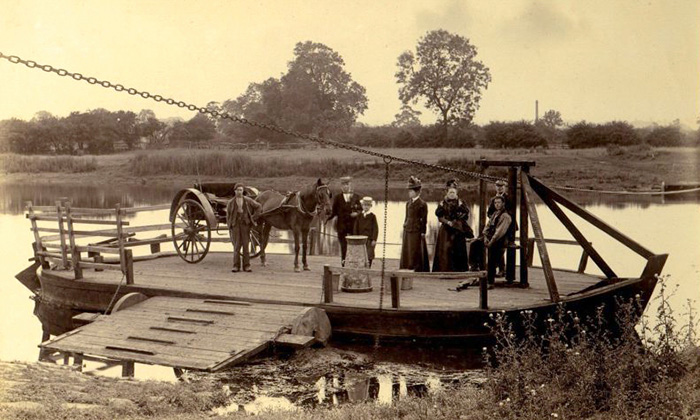 Tywford Ferry, 1889
Tywford Ferry, 1889
In the afternoon of 7th February 1867 John saved three men after a boat collided with the chain of the ferry.
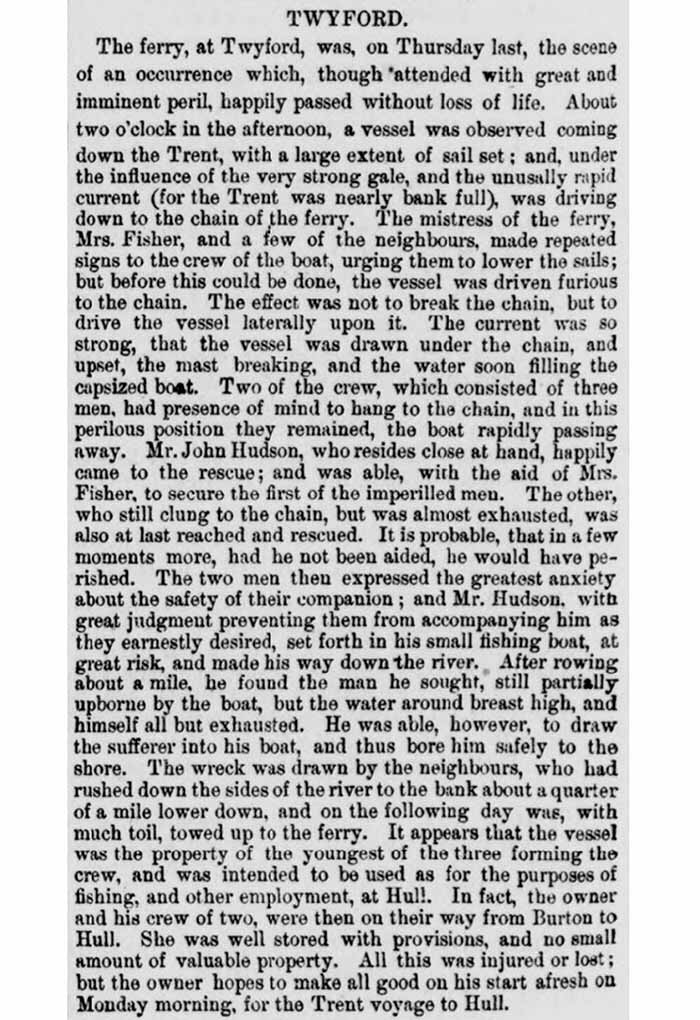
John and Caroline’s last child, Frederick, was born in January 1868. He was baptised with Charlie on 23 July 1871 at Twyford. Together they had produced 14 children, two of whom had died; Mary (their first) in infancy, and Samuel (their second son) to typhoid.
On 20th December 1870 John appeared again at the Derby County Police Court, in a trespassing case.
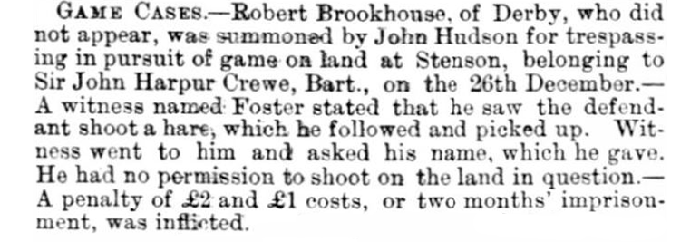
At the time of the 1871 census, John, Caroline, and the family were living at Twyford. Also living with them was Caroline’s widowed father, William Dexter, then aged 71. He continued to live with the family until his death in July 1883.
On 5th October 1877, John was a witness at the Derby County Police Court.
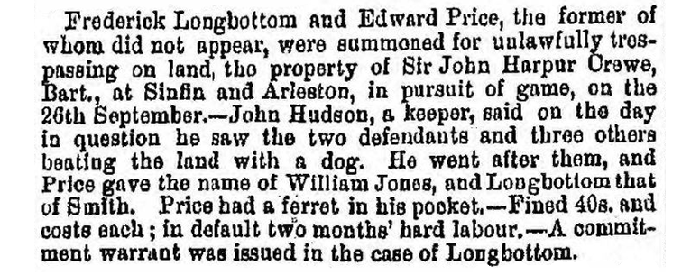
The administration records of the Calke Estate of 1878 document the ‘appointment of John Hudson as Gamekeeper to kill and preserve game within the Manors of Calke, Ticknall, Repton, Smisby, Twyford, Stenson, Swarkestone, Potlocks, Sinfin, Arleston and Stanton by Bridge’. John was a gamekeeper at Calke prior to this date, so this may be a record of his reappointment, or the granting or renewal of his gamekeepers’ licence. Gamekeepers could be fined if they were caught killing game outside the manor where they were employed. The licence also allowed game to be captured out of season for breeding purposes.
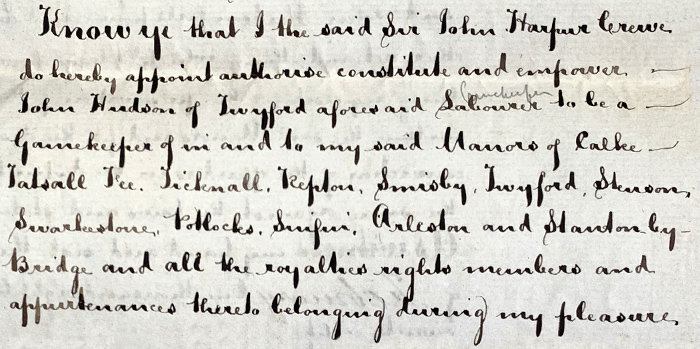 Deputation of Gamekeeper (extract) | 16th February 1878
Deputation of Gamekeeper (extract) | 16th February 1878
Also in 1878, for his daughter Martha’s 24th birthday, John presented her with an album containing family portraits, inscribing the first page with the name by which she was known: ‘Pattie’.
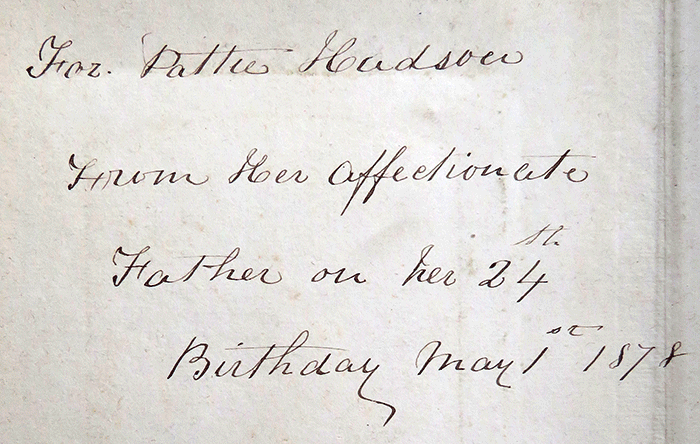
As a gamekeeper John would be working with the local police to capture night poachers. He had some success in the early hours of Saturday 27th July 1878.
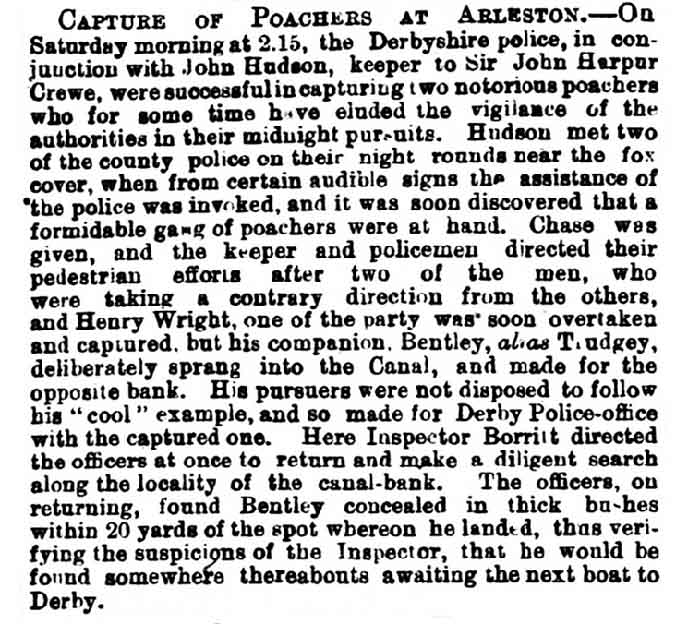
Next door to the Hudsons lived Jane Gilbert, a widow. Leslie Cox noted that ‘although life in the Hudson household was simple, they were never short of food and John Hudson always made sure that Jane did not go without. When there was something left over on the table he would call out “Sweep it off to Jane’s” and the food would be taken next door. Jane was a great favourite with the Hudson children, especially the boys, who would seek refuge there when as frequently happened, their mother became a bit too overpowering.
‘In the Hudson household, religious observance was strict, in keeping with the times, with attendance at Twyford Church on Sunday morning and Stenson Chapel in the afternoon. Caroline Hudson ruled her family with a rod of iron. Her strictness in all matters is supposed to have been due in part, to a reaction against the more relaxed style of her own mother, Martha Dexter...Caroline never announced her plans to the family beforehand and if, for instance, she decided to go with the pony and trap to Derby on the regular market trip on Friday, she would make this known by appearing at the door in her travelling dress. Sufficient of the produce intended for market then had to be removed to make room for her. On one occasion, after the children had gone to bed, she noticed that one of the home made cheeses had been nibbled by one of the boys and, recognising the culprit from the teeth marks, she went straight upstairs and set about the unfortunate Charlie with a stick. Caroline’s oppressive regime was such that it was once said to be a crime even to laugh in the Hudson household. Not unnaturally this drove the boys at least, to seek entertainment elsewhere, even if this meant going next door to play cards with Jane Gilbert. On these occasions, Jane would hastily spread the table cloth over the cards if Caroline’s footsteps were heard coming along the garden path.’
Leslie Cox continues: ‘By contrast, John Hudson was a kind man, highly respected by everyone...On one occasion when Caroline was scolding the children, John said “I think sometimes you are a bit too strict with these children, Caroline”, to which she replied “With all this brood, John, if someone in this house had not been strict there would have been no room for you and me on the hearth”. On another occasion, when their daughter Caroline came over from Tissington with her husband Richard Wain, the Tissington schoolmaster [who she married in 1868] and their sons, Richard asked for pencils and paper, saying that he wished to compare the abilities of the younger Hudson children with his own. John Hudson refused, saying that the children were on holiday and had enough of that sort of thing at school.’
In his notes, Leslie Cox wrote that ‘John Hudson recalled walking home one night from Calke. When climbing a stile in a lonely spot on the Ingleby-Foremark Road, he had the unnerving experience of placing his hand on that of a poacher, one of a gang hiding in the ditch. John Hudson took his hand away and carried on his journey. He knew it would have been foolish and dangerous to interfere.’
On 18th December 1880, John was out walking with his son Arthur when they saw poachers. Arthur managed to get hit on the head with a spade.
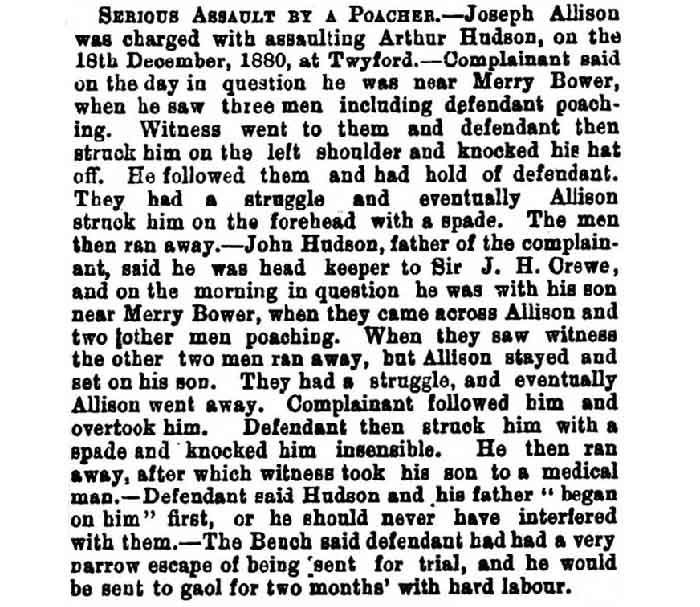
John’s son Arthur also worked as a gamekeeper at Twyford, responsible for the estate north of the river. The Calke Estate holds records for him from 1881 to 1912.
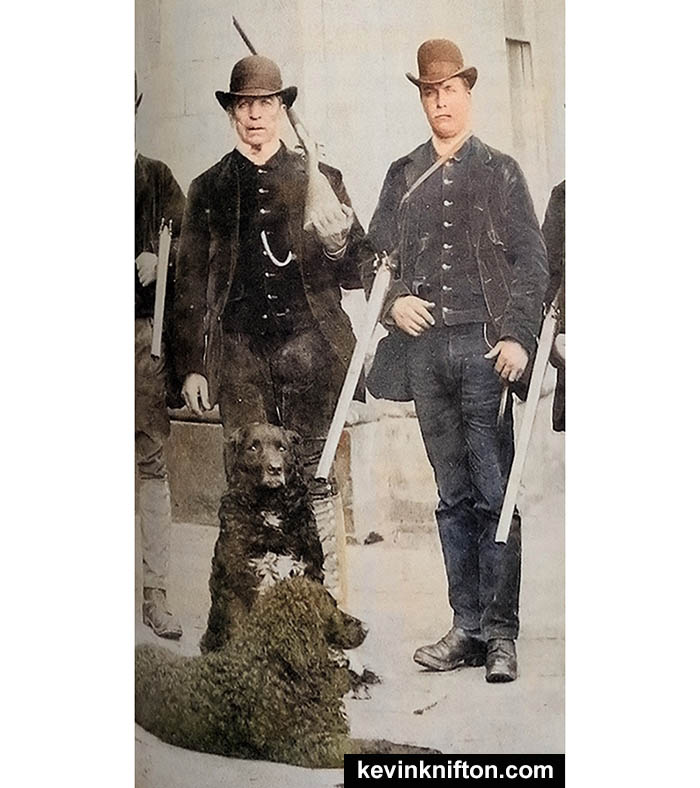 John and Arthur Hudson, and Fan the retriever, 1886.
John and Arthur Hudson, and Fan the retriever, 1886.
The petty sessions at Repton on 25th November 1885 record John Hudson bringing a case of ‘trespassing in pursuit of game’.

Sir John Harpur-Crewe died in 1886 and John Hudson’s name is included in the list of servants at the funeral. Sir John was succeeded by his son Vauncey as 10th baronet.
In the same year, noted Leslie Cox, ‘an attempt was made by a newly formed company to re-open the river through Twyford for navigation by steam boats, to replace horse-drawn barge traffic which had ceased about fifty years before. The proposal, which involved considerable interference with the fords and ferries, and the course of the river generally, was vigorously opposed by the landowners, not least by Sir Vauncey, and John Hudson and his son Arthur were instructed to patrol the river bank at Twyford with shotguns, to keep off the surveyors in order to frustrate a plan to replace Twyford ferry with a bridge.’
In December 1886, Caroline Hudson died at the age of 63. She was buried in the churchyard of St Andrew’s Church on 14th December.
In February of 1887 John came across a lost spaniel and a notice was placed in the local newspaper over five days.

As a gamekeeper, John was also responsible for protecting the fishing.
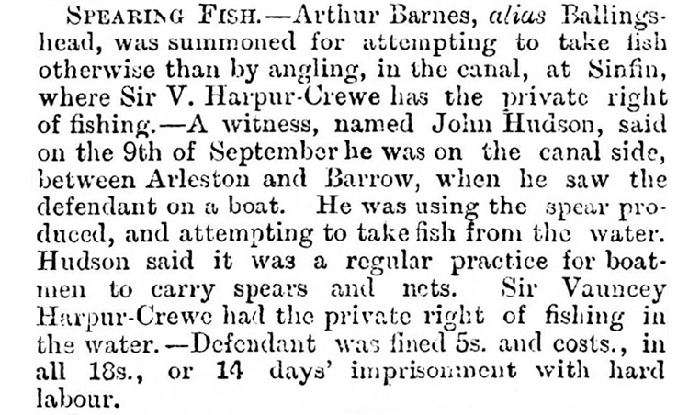
At the time of the 1891 census, John was 71 years old and still working as a gamekeeper. His daughter Martha, son Arthur, and granddaughter Alice Cronshaw, were living with him. He also still had his black retriever dog, Fan, although in 1893 she went missing.

John Hudson died on 17th April 1894, aged 74. His funeral was held on 21st April, followed by interment in the churchyard at St Andrew’s Church.
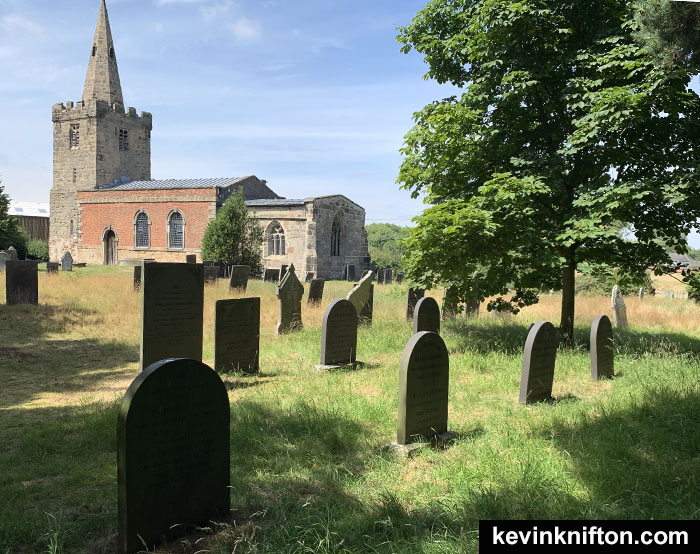 The Hudson graves at Twyford.
The Hudson graves at Twyford.‘In memory of John Hudson, who died April 17, 1894, aged 75 Years. Also of Caroline, wife of the above who died December 10, 1886, aged 63 years. “With Christ which is far better.”’
In his Will, written on 20th August 1886, John appointed his wife Caroline, his son John, and his son-in-law Robert Cronshaw as the executors of his Will. He bequeathed his personal estate to John Hudson and Robert Cronshaw ‘upon trust to allow my wife Caroline Hudson to have the use and enjoyment thereof’ and directed that after Caroline’s death his personal estate should be divided in equal shares to all his children. Caroline had predeceased John.
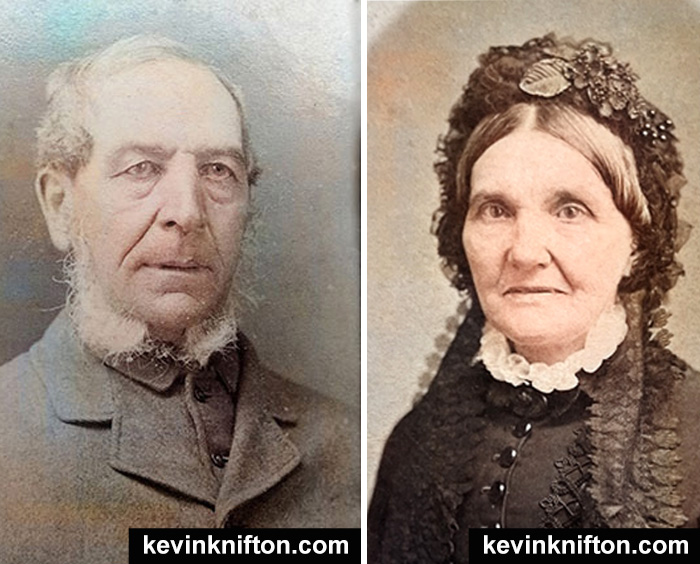
John and Caroline Hudson were my great-great-great-grandparents.
1 Leslie Carl Cox 1923-2011
2 L. J. Cox, Over the Hills to Calke: 150 Years of Memories of Calke Abbey and the Harpur-Crewes (2000), Chapter 8.